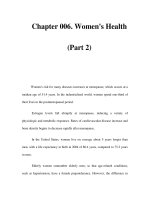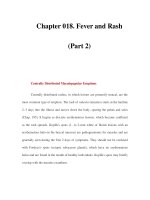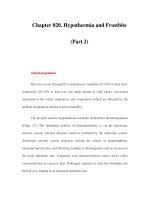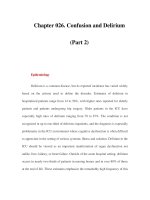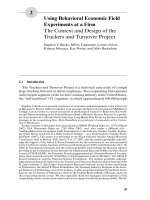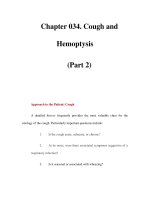Chapter 034. Cough and Hemoptysis (Part 2) ppsx
Bạn đang xem bản rút gọn của tài liệu. Xem và tải ngay bản đầy đủ của tài liệu tại đây (50.92 KB, 5 trang )
Chapter 034. Cough and
Hemoptysis
(Part 2)
Approach to the Patient: Cough
A detailed history frequently provides the most valuable clues for the
etiology of the cough. Particularly important questions include:
1. Is the cough acute, subacute, or chronic?
2. At its onset, were there associated symptoms suggestive of a
respiratory infection?
3. Is it seasonal or associated with wheezing?
4. Is it associated with symptoms suggestive of postnasal drip
(nasal discharge, frequent throat clearing, a "tickle in the throat") or
gastroesophageal reflux (heartburn or sensation of regurgitation)? However,
the absence of such suggestive symptoms does not exclude either of these
diagnoses.
5. Is it associated with fever or sputum? If sputum is present,
what is its character?
6. Does the patient have any associated diseases or risk factors
for disease (e.g., cigarette smoking, risk factors for infection with HIV,
environmental exposures)?
7. Is the patient taking an ACE inhibitor?
The general physical examination may point to a systemic or
nonpulmonary cause of cough, such as heart failure or primary nonpulmonary
neoplasm. Examination of the oropharynx may provide suggestive evidence for
postnasal drip, including oropharyngeal mucus or erythema, or a "cobblestone"
appearance to the mucosa. Auscultation of the chest may demonstrate inspiratory
stridor (indicative of upper airway disease), rhonchi or expiratory wheezing
(indicative of lower airway disease), or inspiratory crackles (suggestive of a
process involving the pulmonary parenchyma, such as interstitial lung disease,
pneumonia, or pulmonary edema).
Chest radiography may be particularly helpful in suggesting or confirming
the cause of the cough. Important potential findings include the presence of an
intrathoracic mass lesion, localized pulmonary parenchymal opacification, or
diffuse interstitial or alveolar disease. An area of honeycombing or cyst formation
may suggest bronchiectasis, while symmetric bilateral hilar adenopathy may
suggest sarcoidosis.
Pulmonary function testing (Chap. 246) is useful for assessing the
functional abnormalities that accompany certain disorders producing cough.
Measurement of forced expiratory flow rates can demonstrate reversible airflow
obstruction characteristic of asthma. When asthma is considered but flow rates are
normal, bronchoprovocation testing with methacholine or cold-air inhalation can
demonstrate hyperreactivity of the airways to a bronchoconstrictive stimulus.
Measurement of lung volumes and diffusing capacity is useful primarily for
demonstration of a restrictive pattern, often seen with any of the diffuse interstitial
lung diseases.
If sputum is produced, gross and microscopic examination may provide
useful information. Purulent sputum suggests chronic bronchitis, bronchiectasis,
pneumonia, or lung abscess. Blood in the sputum may be seen in the same
disorders, but its presence also raises the question of an endobronchial tumor.
Greater than 3% eosinophils seen on staining of induced sputum in a patient
without asthma suggests the possibility of eosinophilic bronchitis. Gram and acid-
fast stains and cultures may demonstrate a particular infectious pathogen, while
sputum cytology may provide a diagnosis of a pulmonary malignancy.
More specialized studies are helpful in specific circumstances. Fiberoptic
bronchoscopy is the procedure of choice for visualizing an endobronchial tumor
and collecting cytologic and histologic specimens. Inspection of the
tracheobronchial mucosa can demonstrate endobronchial granulomas often seen in
sarcoidosis, and endobronchial biopsy of such lesions or transbronchial biopsy of
the lung interstitium can confirm the diagnosis. Inspection of the airway mucosa
by bronchoscopy may also demonstrate the characteristic appearance of
endobronchial Kaposi's sarcoma in patients with AIDS. High-resolution computed
tomography (HRCT) can confirm the presence of interstitial lung disease and
frequently suggests a diagnosis based on the specific abnormal pattern. It is the
procedure of choice for demonstrating dilated airways and confirming the
diagnosis of bronchiectasis.
A diagnostic algorithm for evaluation of subacute and chronic cough is
presented in Fig. 34-1.
Figure 34-1
Algorithm for management of cough lasting >3 weeks. Cough between 3
and 8 weeks is considered subacute; cough >8 weeks is considered chronic. Hx,
history; PE, physical examination; ACEI, angiotensin-converting enzyme
inhibitor; Rx, treat; CXR, chest x-ray.
